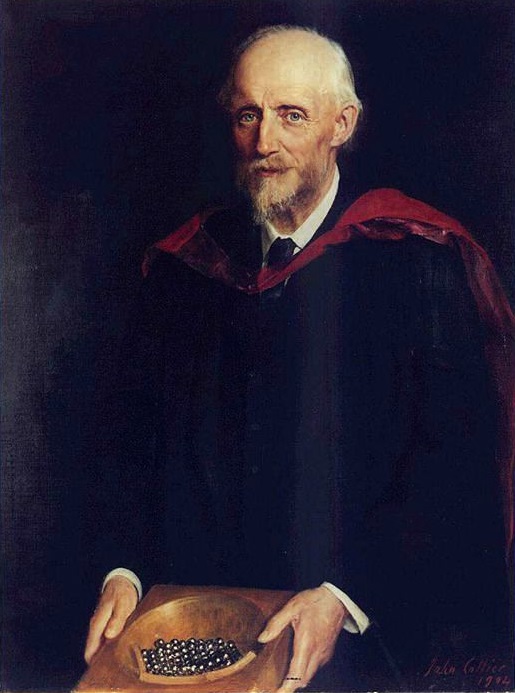Hydrodynamic Lubrication Redux
Evan Zabawski | TLT From the Editor November 2012
History proves the axiom “Publish or perish.”

Though Osborne Reynolds’ theory of the “granularity” of nature was eventually disproven, the image of him holding a curved bowl with two layers of grain in conformity is the most common depiction.
It was recently suggested that TLT reprint some of the outstanding articles that have been published in
Lubrication Engineering (TLT’s predecessor). So this month we start with “What is EHD?” by Vern Wedeven (see article
here), previously published in June 1975. As I read over the article, I found it referenced a very well-known paper first published in 1886 entitled, “On the Theory of Lubrication and its Application to Mr. Beauchamp Tower’s Experiments Including an Experimental Determination of the Viscosity of Olive Oil,” by Osborne Reynolds (of Reynolds number fame). This 78-page paper presents us with an interesting story.
Beauchamp Tower was experimenting with a journal bearing test rig, designed to mimic the conditions of a railway axle box in order to measure friction. Using this apparatus, he verified that the coefficient of friction varied with load and velocity and published these findings in 1883. In his final phase of experiments, he drilled a hole in the bearing for the installation of a lubricator, but for unknown reasons he reassembled the bearing and put it into operation before the lubricator was installed. Tower witnessed oil leak out of this hole during experiments and when he tried to plug it with a wooden plug, he watched in vain as pressure slowly pushed it out.
When Tower mounted a pressure gauge to the hole, he found the pressure exceeded the scale of the gauge, even though the load typically averaged only 100 psi. He then systematically explored the distribution of pressure over the surface of the bearing by drilling more holes and connecting them to pressure gauges. What Tower discovered was that the pressure was asymmetrical and that a fluid film of finite thickness could be maintained in a loaded bearing without the need for an external pump, which we call full-film or hydrodynamic lubrication today.
After these results were presented in Tower’s second paper in 1885, Reynolds rushed the aforementioned paper to publication. The paper was reviewed by Lord Rayleigh (the first to correctly explain why the sky is blue) and George Stokes (the unit for measuring viscosity is named after him for his contributions on fluid dynamics). Around 1884 Stokes had announced he was working on an analysis of Tower’s initial findings. Therefore, Reynolds was committing a faux pas by having stepped in academic territory that was marked out by his senior.
Ultimately, the paper equated to a second-order differential equation, a simplification of the Navier-Stokes equation—so complex it took years before it was solved for journal bearings. The two integrals he needed could be found in several textbooks at the time, and one was even on a math exam he wrote in 1863. Reynolds’ ability to integrate is perhaps evidenced by his decision to expand the equation.
What is of further interest is that Reynolds chose to only use olive oil, when Tower had also used lard, sperm, rape and mineral oil in his experiments. The fact Reynolds had not requested a sample of the mineral oil that Tower had used suggests Reynolds did not want Tower to know of his progress on the problem. This distance continued when Reynolds did not review Tower’s third or fourth papers. Had he done so, he may have discovered the mechanism of parallel surface thrust bearings a full 60 years before they were eventually rediscovered by Fogg in 1946.
During the same period, Reynolds also worked on his theory of the “granularity” of nature, namely that an array of grains (in the order of 10,000 times smaller than an electron) were responsible for the physical properties of matter. Though this theory was eventually disproven, the image of him holding a curved bowl with two layers of grains in conformity is the most common depiction.
Reynolds’ 1886 paper was hard to follow and did not evoke the collaboration of his peers, yet it remains the seminal work that founded the theory of hydrodynamic lubrication.
 Evan Zabawski, CLS, is a reliability specialist in Edmonton, Alberta, Canada. You can reach him at evan.zabawski@gmail.com
Evan Zabawski, CLS, is a reliability specialist in Edmonton, Alberta, Canada. You can reach him at evan.zabawski@gmail.com.